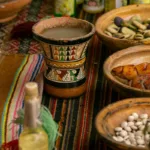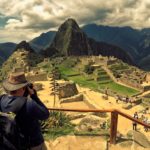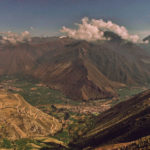Not too far from Cusco you can experience a jewel of the Incan empire. The Q’eswachaka bridge is mark left in Peru by the Tahuantinsuyo culture and is practically conserved as a perfect replica. In thanks to the great efforts of the local populations continuous reparations and ceremonies.
This area contains history of the ancients, and an annual ritual is held to celebrate the preservation of this monument. This is an excellent opportunity for tourists to encounter local traditions and tour the area.
We will tell you a little about the history of this ancient bridge, the annual ritual held around its preservation, where it is, and how to get to this wonderful tourist attraction.
Our agency has a special tour regarding this beautiful area- Puente Inka Q’eswachaka which also includes a day tour to the rainbow mountain, Palcoyo.
Where is Q’eswachaka?
Q’eswachaka (In the Quechua language, Q’eswachaka, and in local dialects [qʼeswɐˈt͡ʃɐkɐ] o [qʼeʃwɐˈt͡ʃɐkɐ]) is the name of a suspension bridge made with a vegetable fiber (ichu) that is located on the Apurímac River in the district of Quehue, in the province of Canas in the department of Cuzco in southern Peru.
This area is more than 4 hours outside of the city of Cusco, and you can visit before or after seeing the rainbow mountain, Palcoyo. Visiting Q’eswachaka is a day trip, as long as you leave early to give yourself time to appreciate and enjoy this incredible attraction.
How do I get there?
You can arrive on your own by taking a bus from the Plaza de Armas in Cusco to Combapata. Then, you must travel to Yanaoca. The trip is very nice for spanning landscapes and especially because of the view of Lake Pampamarca. Then you must move on to Qehue and here you have two options: pay a cab to take you to the bridge or go walking. It is not far away so it is best to walk.
There is a 10 sol fee to cross the bridge, don’t forget your wallet!
You can also go by direct bus from Cusco or hire a tour that will make you live a one day experience in this emblematic tourist site. Tours usually cost around 150 soles, which can take away a lot of the hassle of attempting to find the site yourself.
Why is Q’eswachaka a tourist attraction?
This is bridge is the only of it’s kind in all of Peru. It is a well-preserved remnant of the history of the Incan Empire. According to estimates, this bridge might be more than 500 years old.
The materials and how they are cared for are one of the most striking features of this site. The maintenance and renovation is carried out through a ritual executed by the communities of Winch’iri, Chaupibanda, Ccollana Quehue and Perccaro, who live in the surrounding areas of this mountainous region of Cusco.
Q’eswachaka measures 33 meters long and 1.20 meters wide. This impressive structure is entirely made “ichu” braided together into ropes, and swings 15 meters above the Apurímac River.
History
More than 500 years ago, when the Inca Empire was at its peak, there were numerous bridges such as Q’eswachaka in the region. They were built using only ichu and tree trunks tied to a stone structure that was specially made to hold the bridge. These roads united towns and communities that were in different slopes of the mountains. Without these bridges these communities would have rarely had contact. These bridges served as a pedestrian crossings but also as a means of transport for moving products from one place to another.
With regard to maintenance, the Incas were clear that they should do it every one or two years, depending on the use and wear of ichu and wood. The renovation of these materials was done according to the indications of the Inca specialist called «Mitmaq». According to historical documents that were found, the maintenance of these bridges was done at great speed during the reign of the Incan government.
With the fall of the Incan Empire, bridges continued to be used, even during the colonial period. The reason was that their structures were more resistant to earthquakes than the stone bridges built by the Spaniards.
What does the ritual of repairing the bridge entail?
Renewing the bridge structure is not an activity that is taken lightly. Changing the materials implies carrying out a very important ritual for the communities involved. The maintenance ritual of Q’eswachaka is carried out through a working model that dates back to Inca times and is called “Minka”. This work has various ritual and festive activities that last 4 days, and usually starts on the first Sunday of June.
During the first day a ritual is celebrated to the «APU Q’eswachaka». It starts in the early hours of the day, at dawn. While the rite is carried out, the “qoya ichu” is collected and then braided into soguillas called “q’eswas”. This braiding task is performed only by women under the supervision of a “chakaruwak” or specialist.
On the second day the ichu structure of the old bridge is dismantled, the stone nails that hold the bridge are removed and 4 ropes are placed that will serve as the basis for the structure of the new bridge.
On the third day the handrails and the surface where they will walk will be finished. Finally the fourth day is celebrated with dances and a lot of typical food, since the communal work was always considered as a holiday by the Peruvian ancestors.
Around 1000 people from the communities of Winch’iri, Chaupibanda, Ccollana, Quehue and Perccaro are involved in the construction of this unique suspension bridge of Inca origin.
Declaration of National Cultural Heritage
This bridge is so important in the history of the Incan Empire and of Peru, that on August 5, 2009, the National Institute of Culture of Peru declared it as a national cultural heritage site. Not only the bridge was recognized, but also the “ritual of renovation of the Q’eswachaka bridge, as well as the knowledge associated with its history and construction”.
Experience the Rainbow mountain, Palcoyo
If you want, you can not only visit Q’eswachaka in a single day but also the rainbow mountain, Palcoyo. This option is a very attractive option since both destinations are on the same route and you can visit them in whatever order you want. You should only get up early to leave Cusco and have the day be profitable.
Palcoyo is a perfect destination to contemplate a magical landscape that is 5,000 meters above sea level. It can be reached by trekking. Although it is very cold, it is a once in a lifetime journey. The hill seems painted with 7 different colors and from the vantage point you can contemplate the majestic snowy Ausangate (a nearby mountain) and admire the rainbow valley. Few tourists visit this site since most travelers choose to go to the other rainbow hils of Vinicunca. In Palcoyo you will not be rushed, so you can enjoy the sights calmly. You will be able to enjoy the solitude and silence offered by this impressive tourist attraction of Cusco. Hope to see you soon!





